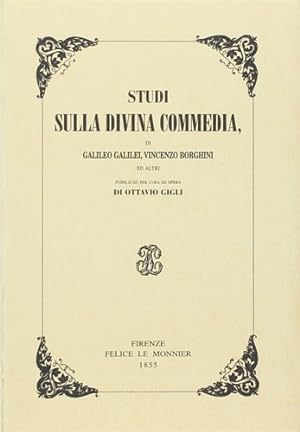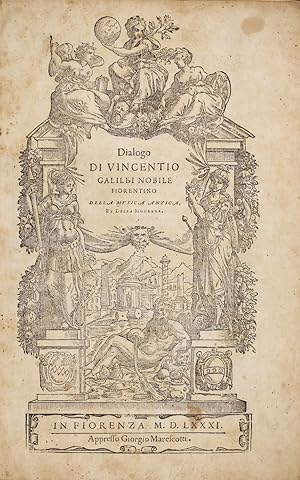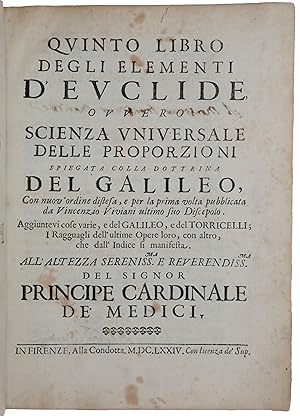galileo vincenzo (5 resultados)
Tipo de artículo
- Todo tipo de artículos
- Libros (5)
- Revistas y publicaciones
- Cómics
- Partituras
- Arte, grabados y pósters
- Fotografías
- Mapas
-
Manuscritos y
coleccionismo de papel
Condición
Encuadernación
Más atributos
- Primera edición (2)
- Firmado (1)
- Sobrecubierta
- Con imágenes del vendedor (4)
- Sin impresión bajo demanda (4)
Gastos de envío gratis
Ubicación del vendedor
Valoración de los vendedores
-
Studi Sulla Divina Commedia (Classic Reprint)
Publicado por Forgotten Books, 2018
ISBN 10: 0282792252ISBN 13: 9780282792251
Librería: Forgotten Books, London, Reino Unido
Libro Impresión bajo demanda
Paperback. Condición: New. Print on Demand. Excerpt from Studi Sulla Divina Commedia. About the Publisher, Forgotten Books publishes hundreds of thousands of rare and classic books. This book is a reproduction of an important historical work. Forgotten Books uses state-of-the-art technology to digitally reconstruct the work, preserving the original format whilst repairing imperfections present in the aged copy. In rare cases, an imperfection in the original, such as a blemish or missing page, may be replicated in our edition. We do, however, repair the vast majority of imperfections successfully; any imperfections that remain are intentionally left to preserve the state of such historical works. This text has been digitally restored from a historical edition. Some errors may persist, however we consider it worth publishing due to the work's historical value. The digital edition of all books may be viewed on our website before purchase. print-on-demand item.
-
Studi sulla Divina Commedia.
Publicado por Le Monnier, Firenze,, 2000
ISBN 10: 8800812945ISBN 13: 9788800812948
Librería: FIRENZELIBRI SRL, Reggello, FI, Italia
Libro
Condición: BUONO. A cura di Ottavio Gigli. cm.12,5x18, pp.XXXVII,366, Ristampa anastatica dell'ediz.Firenze,1855. Firenze, Le Monnier cm.12,5x18, pp.XXXVII,366, legatura editoriale sopracoperta. Ristampa anastatica dell'ediz.Firenze,1855. legatura editoriale sopracoperta.
-
La vita ed alcune lettere familiari di Galileo Galilei
Publicado por Venezia, Alvisopoli, Venezia, 1826
Librería: Libreria Spalavera, Verbania, Italia
Condición: Buono (Good). 16°, mm 170x105, pp. 254, brossura editoriale, titoli a stampa in cornice ornata incisa, velina protettiva, eccellente esemplare, ex libris applicato al contropiatto. Ritratto di Galileo dipinto da Giusto Suttermans e inciso da Marco Comirato (Venezia c.1800-1869), contiene le principali notizie sulla vita dell' autore appositamente scritte (1654) per il Granduca Leopoldo dal fisico fiorentino Vincenzo Viviani, curatore delle sue opere, ed una interessante scelta di lettere scientifiche ed alcune private di Galilei, fra cui quelle relativa alla sua difesa per l' abiura; fa parte della raffinata Collezione curata da Bartolomeo Gamba Operette di instruzione e di piacere scritte in prosa da celebri italiani antichi e moderni. Book.
-
Dialogo di Vincentio Galilei, nobile Fiorentino. Della musica antica, et della moderna
Publicado por In Fiorenza, appresso Giorgio Marescotti appresso Giorgio Marescotti, 1581
Librería: Delirium Books · Susana Bardón, Madrid, España
Original o primera edición
Encuadernación de tapa dura. Condición: Bien. 1ª Edición. Fol. (33,2 x 21 cm.) 2 h. inc. port. grabada en madera, 149 p., 5 h. sin num. de tabla, al vuelto de la última el colofón. Cabeceras, capitulares y grabados en texto, algunos a toda plana. Plena piel del XVIII, lomo desgastado, algo abierto por los cajos, hierros dorados, tejuelo parcialmente conservado. Primera edición de una de las obras más importantes en la historia de la música, en especial de la melodía y la ópera barrocas. Tiene la particularidad de ser el primer libro en contener el primer ejemplo de grabado musical. Vincenzo Galilei, padre de Galileo Galieli, fue un consumado compositor, laudista, cantante y compositor florentino, cuyo rechazo a la polifonía allanó el camino para la ópera. Fue de los primeros músicos en someter el sonido instrumental a la razón de la ciencia empírica. Se dice que fueron los experimentos de Galilei con el sonido el origen de la física experimental, lo que llevaría a su hijo a cuestionarse el mundo para verificar las leyes de la naturaleza como un hecho empírico. Vincenzo Galilei estableció las bases sobre las que se construiría la nueva música , relacionando las palabras y el sonido con el mundo emocional del oyente. Y, desde ese preciso instante, la Teoría de los Afectos dejó de ser solo teoría, convirtiéndose en un lenguaje que hace partícipe de sus efectos al espectador. Última hoja remarginada y con injerto en la mitad inferior. Pequeño desgarro en la esquina superior del fol. 115 sin afectar al texto. Adams G 139; Cinti 6; RISM B. IV, p. 344; Eitner IV, 128; Fetis III, p. 384.
-
Quinto libro degli Elementi d'Euclide, ovvero Scienza universale delle proporzioni speigata colla dottrina del Galileo, con nuov' ordine distesa, e per la prima volta pubblicata . Aggiuntevi cose varie, e del Galileo, e del Torricelli; i ragguagli dell'ultime opoere loro, con altro, chedall' indicie si manifesta
Publicado por Condotta, Florence, 1674
Librería: SOPHIA RARE BOOKS, Koebenhavn V, Dinamarca
Miembro de asociación: ILAB
Original o primera edición Ejemplar firmado
First edition. SIGNED AND INSCRIBED BY VIVIANI TO MARIOTTE. The true first edition, very rare, signed and inscribed by Viviani to Edme Mariotte, of this important Galileanum, an assembly of previously unpublished writings by Galileo, together with texts by Torricelli and Viviani himself. Most importantly, it contains the first printing of a Galileo manuscript concerned with the Eudoxian theory of proportion which may be regarded as a supplement to the Discorsi (1638); the manuscript had been given to Viviani (1622-1703), Galileo's distinguished pupil, amainuensis, and biographer, by Cardinal de' Medici. Galileo had composed this manuscript in response to Viviani's demand that Galileo provide a more secure geometrical basis for his theory of falling bodies. As Galileo wrote to Benedetto Castelli in 1639, 'Objections made to me many months ago by this young man [Viviani] who is now my guest and disciple, against that principle postulated by me in my treatise on accelerated motion . made me think about this again in such a way as to persuade him that that principle might be conceded as true. Finally, to his and my great delight, I succeeded in finding a conclusive demonstration" (Boschiero, pp. 43-44). The manuscript had been dictated, in dialogue form, by Galileo to Torricelli in November 1641 (Galileo died on January 9, 1642). Since Torricelli's book on the theory of proportion (written in 1647) was not published, this edition by Viviani of Galileo's Fifth Day of the Discorsi (pp. 61-78) is the first printing of Galileo's reform of Book V of the Elements. It contains "Galileo's reflections on two definitions found in Euclid's Elements, that of 'same ratio' in Book V, and that of 'compound ratio' on Book VI. These were the two most important keys taken from antiquity in creating Galileo's mathematical physics . Galileo's critique of these definitions is by no means trivial. His discussion of Book V, Definition V, shows how a rigorous theory of irrational magnitudes can be built on the natural numbers by means of equimultiples . That is a large step in formulating a rigorous analysis of the continuum. His discussion of the spurious Book VI, Definition V illuminates the nature of mathematical definitions in general, essential to foundational analysis" (Drake, pp. 421-422). Galileo's treatise is prefaced by Viviani's own attempt to render more rigorous the theory of proportions, which includes ten new principles (pp. 1-60). The work also includes 12 letters from Galileo to an unnamed French scholar, an unpublished treatise by Galileo on the 'angle of contact', other unpublished works by Galileo on topics including the construction and use of telescopes and the movement of animals, and writings by Torricelli on Euclid, Book VI, and by Viviani on Euclid, Book I. A second edition was issued in 1676, with a second part containing the solution of 36 problems which had been published as challenges by a Leiden student in 1675, and with the dedication dated 16 May 1676, although the title page date remained 1674. The first edition is very rare: ABPC/RBH list only this copy since 1961. Institutional holdings are difficult to assess as collations are rarely given and the title page carries the same date in both editions. Provenance: Edme Mariotte, French physicist known for formulating Boyle's law independently - "honored as the man who introduced experimental physics into France, Mariotte played a central role in the work of the Paris Academy of Sciences from shortly after its formation in 1666 until his death in 1684" (DSB) (inscribed by Viviani on title verso 'A Monsieur Mariotte' and 'Vinc. Viviani' at bottom right); inscription of a Jesuit seminary on half-title recto, shelf-marks on front endpapers. "Viviani (1622-1703) was the son of Jacopo di Michelangelo Viviani, a member of the noble Franchi family, and Maria Alamanno del Nente. He studied the humanities with the Jesuits and mathematics with Settimi, a friend of Galileo's. His intelligence and ability led to his presentation in 1638 to Ferdinand II de' Medici, grand duke of Tuscany. Ferdinand introduced him to Galileo, who was so impressed by his talent that he took him into his house at Arcetri as a collaborator in 1639" (DSB). "Often described as 'Galileo's last student,' Viviani is a principal actor in the standard account of the reception of the Two New Sciences, included for his devotion to his late teacher and for the volume of textual material he preserved and produced . Viviani is often considered in tandem with another of Galileo's students, Evangelista Torricelli. Torricelli and Viviani served successively in Galileo's former position as mathematician to the Grand Duke of Tuscany . After Galileo's death, both Viviani and Torricelli continued to work with Galileo's unpublished manuscripts. They developed some of these writings into two additional 'days' to augment the 1638 publication. The Fifth Day was published in 1674 by Viviani as Quinto Libro degli Elementi d'Euclide ovvero Scienza Universale delle Proporzioni (Raphael, pp. 47-48). "During the last months of Galileo's life, as Viviani embarked on a career inside the Tuscan Court, they worked together in order to strengthen the role of mathematics in natural philosophy . The topic they worked on together to achieve this was the geometrical demonstration of accelerating falling bodies. Galileo's and Viviani's combined efforts to illustrate accelerated motion on inclined planes, resulting in the scholium Viviani added to the Third Day of Two New Sciences, became a major part of Viviani's education, shaping the natural philosophical skills, commitments, and agendas he was to use during his entire career . "To complete his dynamical analysis of the ratios of speeds of bodies falling down differently inclined planes, [Galileo] wrote the following postulate; a critical part of his mathematical demonstration of the physical phenomenon of accelerating falling bodies: the body always reaches the same sp.






